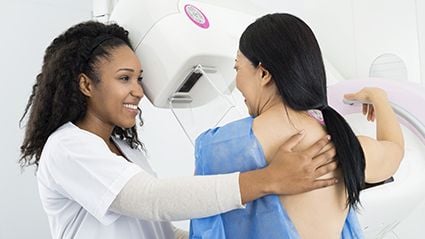
All women should start getting mammograms every other year beginning at age 40, the nation’s top panel of preventive health experts announced Tuesday.
About 20% more lives can be saved from breast cancer by moving the regular screening age up to age 40, rather than starting at age 50, the U.S. Preventive Services Task Force (USPSTF) estimates.
The task force based its recommendation partly on increasing rates of breast cancer in younger women.
“More women in their 40s have been getting breast cancer, with rates increasing about 2 percent each year, so this recommendation will make a big difference for people across the country,” Task Force Chair Dr. Wanda Nicholson said in a USPSTF news release.
Previously, the task force recommended that women decide for themselves between ages 40 and 50 if they wanted regular breast cancer screening, based on their individual risk factors and preferences. All women were encouraged to start by age 50.
Now, all women between the ages 40 and 74 are urged to get a mammogram every other year, the USPSTF says.
Breast cancer is the second most common cancer and the second most common cause of cancer death for women in the United States, the USPSTF said.
The task force also based its updated recommendation on modeling performed for the first time to look at the benefits of screening Black women.
Black women are 40% more likely to die of breast cancer than white women, and often get aggressive cancers at a young age, the USPSTF said.
“This new approach has even greater potential benefit for Black women, who are much more likely to die of breast cancer,” said Nicholson, who is a professor of prevention and community health at the Milken Institute School of Public Health at George Washington University in Washington, D.C.
USPSTF recommendations weigh heavily in the nation’s health care system. The Affordable Care Act requires that insurers cover the entire cost of screenings and services recommended by the task force.
The move marks a shift in the USPSTF’s approach to breast cancer, as their recommendations have tended to be more conservative than those of the American Cancer Society.
The ACS currently recommends that women make an individual decision whether they want to start mammograms between 40 and 44, and then receive annual screenings from 45 to 54. Women 55 and older can switch to every other year mammograms, or keep getting annual screenings.
The USPSTF still differs from the ACS in that it recommends mammograms every other year, while the ACS recommends annual mammography up to age 54.
In a statement, the American College of Radiology (ACR), which represents the nation’s radiologists, said the new recommendations from the USPSTF still “do not go far enough to save more women’s lives.”
The ACR will “continue to urge the USPSTF to recommend all women have a breast cancer risk assessment by age 25… and that women at average risk for breast cancer receive an annual mammography screening starting at age 40.”
The USPSTF also has been hesitant to recommend mammograms past age 74, noting that not enough research has been done on the benefits and harms of continuing the screening into old age.
The task force also noted that nearly half of women have dense breasts, which increases their risk of breast cancer and means that mammograms might not work as well for them.
More research is needed into alternatives to mammograms for these women, potentially including breast ultrasound or MRI.
“Women deserve to have the best science available to guide them on how to protect their health, and we’re asking the research community to prioritize studies that can show us how best to screen for breast cancer in women with dense breasts,” Nicholson said.
“In the meantime, women with dense breasts should talk with their clinician about options for follow-up testing so that they can get the care that’s right for them,” Nicholson concluded.
The updated USPSTF recommendations and the evidence behind them are published April 30 in the Journal of the American Medical Association.
More information
The Cleveland Clinic has more about mammograms.
SOURCE: U.S. Preventive Services Task Force, news release, April 30, 2024
Source: HealthDay
Copyright © 2025 HealthDay. All rights reserved.

Leave a Reply